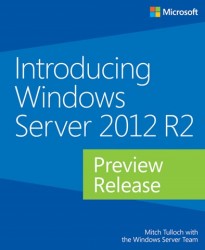 Windows Server 2012 R2 delivers global-scale cloud services which is the heart of Microsoft Cloud OS vision. It also provides new advancements in building IT organizations by promoting private and hybrid cloud infrastructure for their businesses.
Windows Server 2012 R2 delivers global-scale cloud services which is the heart of Microsoft Cloud OS vision. It also provides new advancements in building IT organizations by promoting private and hybrid cloud infrastructure for their businesses.
Here are the some of the new features added to the latest Windows Server 2012 R2,
1. iSCSI Target Server
— It is mainly used for booting network across multiple computers from a single operating system that is stored in a centralized location. It helps in improving efficiency, manageability, availability, and security.
— Improved functionality includes Manageability enhancements, Improved optimization to allow disk-level caching, Scalability limits and Local mount functionality.
— New functionality added are Virtual disks enhancements.
2. Server Message Block (SMB)
— Server Message Block is actually a network file sharing protocol that allows applications on a computer to read and write and request services from server.
— Improved functionality includes Improved performance of SMB Direct, Improved SMB event messages and SMB 1.0
— New functionality added are Automatic re-balancing of Scale-Out File Server clients, VHDX files as shared storage for guest clustering, Hyper-V Live Migration over SMB, Improved SMB bandwidth management and Support for multiple SMB instances on a Scale-Out File Server.
3. Windows Deployment Services (WDS)
— It is a server role which enables us remotely deploy Windows operating systems.
— Improved functionality included in Operating systems, Image types, boot environment, Multi-casting, driver provisioning, extensible and Extensible Firmware Interface (EFI).
4. Active Directory
— Active directory focuses in empowering their users to be productive.
— Improved functionality includes authentication, Single sign-on (SSO), Web Application Proxy, Multi-factor Access Control and Multi-Factor Authentication (MFA).
5. DFS Replication
— It is a role service in the File and Storage which enables in replicating folders across multiple servers and also in sites.
— Improved functionality includes Membership disabling improvements and Unexpected shutdown database recovery.
— New functionality added are Windows PowerShell module, Windows Management Infrastructure provider, Database cloning for initial sync, Database corruption recovery, Cross-file RDC (Remote Differential Compression) disable, File staging tuning and Preserved file restoration.
— Deleted functionality is File Replication Service (FRS) which was previously used in windows server 2003.
6. Dynamic Host Configuration Protocol (DHCP)
— It is an Internet Engineering Task Force (IETF) which was designed with the mission to reduce the administration burden and complexity of configuring hosts on TCP/IP.
— Improved functionality includes Windows PowerShell for DHCP server.
— New functionality added are DNS registration enhancements and DNS PTR registration options.
7. Hyper-Virtualization (Hyper-V)
— It helps in creating and managing a virtualized computing environment, whereas the hardware provides an environment in which we can run multiple operating systems.
— Improved functionality includes re-size virtual hard disk, live migrations, integration services, export, fail-over clustering, hyper-V replica, linux support and management.
— New functionality added are storage quality of service, virtual machine generation, enhanced session mode and automatic virtual machine activation.
8. IP Address Management (IPAM)
— It is a built-in framework focused on discovering, monitoring, auditing, and managing the IP address space, where it provides for administration and monitoring of DHCP and DNS servers.
— Improved functionality includes Enhanced DHCP server management and Enhanced windows Power shell support.
— New functionality added are role based access control, virtual address space management, external database support, upgrade and migration support.
9. Networking
— Improved functionality included in DNS, DHCP, Hyper-V Virtual switch, IPAM and Windows server gateway.
10. Remote Desktop Services
— It provides technologies that enable users to connect to virtual desktops and remote connectivity.
— Improved functionality includes session shadowing, online data de-duplication, improved RemoteApp behavior, quick reconnect, improved bandwidth, improved compression, RemoteFX vGPU and dynamic display handling.
11. Security and Protection
— Improved functionality includes in Access control, AppLocker, Bit locker, credential locker, smart cards, TLS/SSL, Trusted Platform Module (TPM), User Account Control (UAC), Windows defender and bio-metrics.
— New functionality added are Encrypted hard drives, Virtual smart cards and Exchange ActiveSync Policy Engine
DOWNLOAD LINK
You can download a free “preview” of Windows server 2012 R2 from here.

 Email article
Email article



